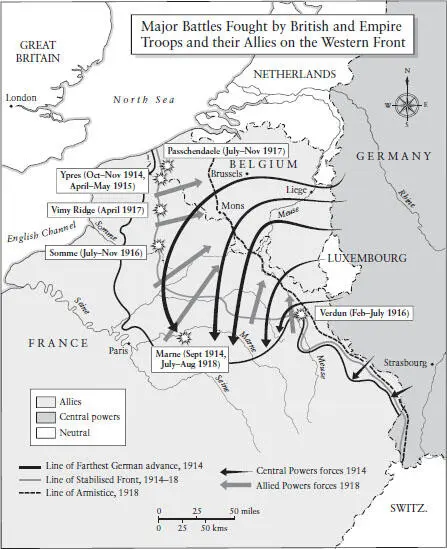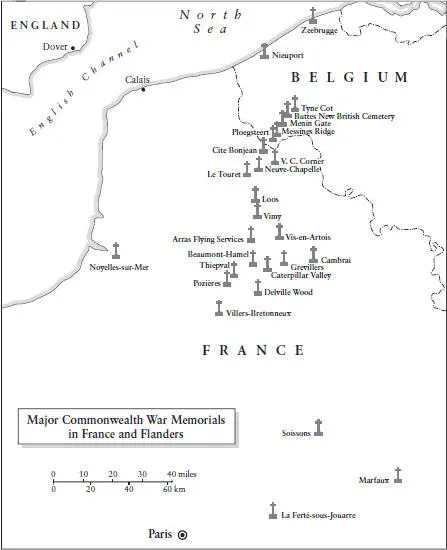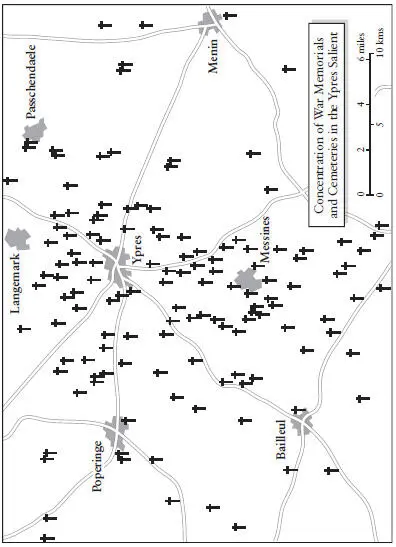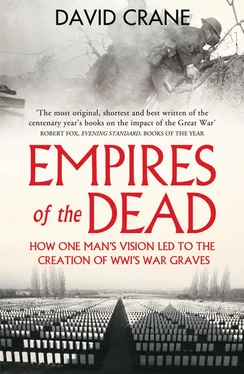EMPIRES OF THE DEAD
How One Man’s Vision Led to the Creation of WWI’s War Graves


CONTENTS
COVER
TITLE PAGE EMPIRES OF THE DEAD How One Man’s Vision Led to the Creation of WWI’s War Graves
MAPS
LIST OF ILLUSTRATIONS
PROLOGUE
1. The Making of a Visionary
2. The Mobile Unit
3. With an Eye to the Future
4. Consolidation
5. The Imperial War Graves Commission
6. Kenyon
7. Opposition
8. The Task
9. Completion
10. Keeping the Faith
PICTURE SECTION
FOOTNOTES
NOTES
SELECT BIBLIOGRAPHY
INDEX
ACKNOWLEDGEMENTS
ALSO BY DAVID CRANE
COPYRIGHT
ABOUT THE PUBLISHER



1. Equestrian Monument to Sir John Hawkwood by Paolo Uccello, 1436, fresco transferred to canvas, post restoration ( Duomo, Florence, Italy / The Bridgeman Art Library )
2. A soldier salutes at a grave prepared for the remains of New Zealand soldiers killed during the Dardanelles campaign at Chunuk Bair on 8 August 1915 (© Imperial War Museum, Q 14340 )
3. Prince of Wales with Fabian Ware and Edwin Lutyens at the unveiling of Lutyens’s Memorial to the Missing of the Somme at Thiepval on 1 August 1932 ( courtesy Commonwealth War Graves Commission )
4. Vendresse Cemetery, France ( courtesy Honor Clerk )
5. Rudyard Kipling and his son John on the yacht Bantam , c .1910 ( Private Collection / Bridgeman Art Library )
6. Caricature depicting a confrontation between Edwin Lutyens and Herbert Baker by William H. Nicholls, c .1914 ( courtesy RIBA Library Drawings & Archives Collections )
7. Charles Holden by Francis Dodd, oil on canvas ( © The Art Workers’ Guild Trustees Limited, London, UK / The Bridgeman Art Library )
8. The main entrance to the Serre Road Cemetery, No. 2, France ( © Maurice Savage / Alamy )
9. Serre Road Cemetery, No. 2, France ( © Maurice Savage / Alamy )
10. Etaples Cemetery, France ( courtesy Honor Clerk )
11. ‘The Cemetery, Etaples, 1919’ by Sir John Lavery, 1919, oil on canvas
12. The Thiepval Memorial to the Missing of the Somme, France, c .1935 ( © Hulton Archive / Getty Images )
13. Stonemason hand-engraving a Canadian headstone destined for a cemetery in France ( courtesy Commonwealth War Graves Commission )
14. Ypres, Belgium in ruins, 1919 ( Photo by W. L. King )
15. ‘Menin Gate at Midnight’ by Will Longstaff, 1927, oil on canvas ( courtesy Australian War Memorial )
16. Reginald Blomfield by James Jebusa Shannon, 1915, oil on canvas ( courtesy RIBA Library Drawings & Archives Collections )
17. Inscription of names at the Menin Gate, Belgium ( © Tim Bekaert )
18. Lone Pine Cemetery, Turkey (© Universal Images Group / DeAgostini / Alamy )
19. Funeral of a St John’s Ambulance Brigade nursing sister, Annie Bain, at Etaples (© Popperfoto / Getty Images )
20. Headstone of nursing sister A. W. Bain ( courtesy Honor Clerk )
21. ‘Mourning Parents’ sculpture by Käthe Kollwitz at Vladslo Cemetery, Germany (© David Crossland / Alamy )
22. Verdun Cemetery, France (© Jean-Pol Grandmont )
23. Tyne Cot Cemetery, Belgium ( Photograph by Brian Harris for the Commonwealth War Graves Commission © 2006 )
24. Funeral of the Unknown Warrior, 11 November 1920 (© Topical Press Agency / Hulton Archive / Getty Images )
25. A sketch of the proposed design for the Cenotaph with explanatory notes by Edwin Lutyens ( © The Artist’s Estate; image © Imperial War Museum , Art.IWM ART 16377 3 )
26. Unveiling of the Cenotaph, 11 November 1920 (© Imperial War Museum , Q 31513 )
27. ‘The Resurrection of the Soldiers’, wall painting at Sandham Memorial Chapel by Stanley Spencer, 1923–7 (© The Estate of Stanley Spencer 2013. All rights reserved DACS; image © National Trust Photographic Library / A C Cooper / The Bridgeman Art Library )
While every effort has been made to trace the owners of copyright material reproduced herein, the publishers would like to apologise for any omissions and would be pleased to incorporate missing acknowledgements in future editions.
They throw in Drummer Hodge, to rest
Uncoffined – just as found:
His landmark is a kopje-crest
That breaks the veldt around:
And foreign constellations west
Each night above his mound.
‘Drummer Hodge’, THOMAS HARDY
High on the north wall of Florence’s Duomo can be seen one of the most arresting images of the early Italian Renaissance. Against a deep red background a knight sits on horseback, a spectral figure painted in a cadaverous terra verde that emerges out of the cathedral gloom like some menacing cross between the great equestrian bronze of Marcus Aurelius and Mozart’s avenging Commendatore.
The fresco is the work of Paolo Uccello, and in it Renaissance and Middle Ages meet. The eyes are sightless, the lips drawn back, but astride his ghostly green charger – off-fore raised, neck curved in a gracefully submissive arc – Uccello’s rider still grasps firmly on to his baton of earthly command. Here, simultaneously, is a celebration of life and memento mori , a portrait of power and dissolution, of individual glory and universal mortality, the creation of an age that understood war and death and had seen more than its fair share of both. Pride, fame, blood-guilt, atonement, hope, gratitude – all those complex feelings that lie behind every war memorial – they are all here, and so too is the universal fact of mortality that unites subject and viewer in one common fate. ‘ Ioannes Acutus Eques Britannicus ’ reads the inscription beneath, ‘ Dux Aetatis Suae Cautissimus Et Rei Militaris Pertissimus Habitus Est ’ – ‘This is John Hawkwood, British knight, esteemed the most cautious and expert general of his age.’
It seems a perverse irony that the first – and for a very long time only – memorial raised on European soil to an English soldier by a grateful government is Florence’s tribute to the great fourteenth-century mercenary and diavolo incarnato , Sir John Hawkwood. Over the centuries that followed Hawkwood’s death, British armies fought and died across the length and breadth of the continent, and yet anyone walking Europe’s battlefields now in search of some trace of their existence would have about as much chance of finding it as they would the snow off the boots of mythical Russian soldiers marching through the north of England in 1914.
Читать дальше

















